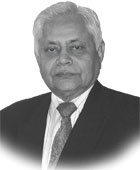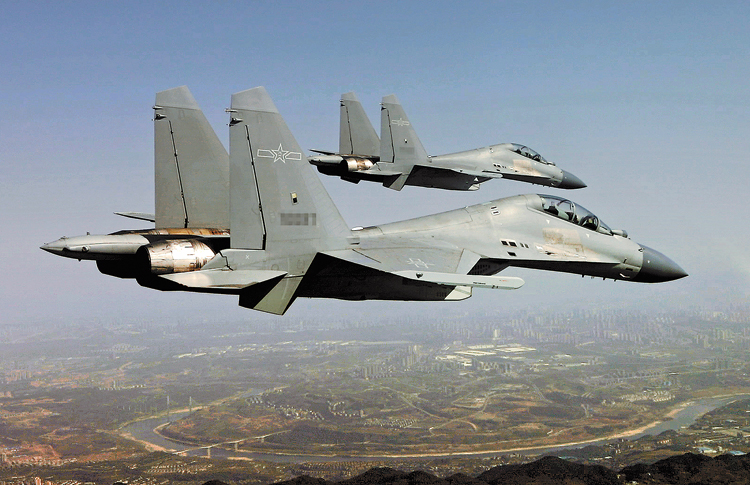INDIAN ARMED FORCES CHIEFS ON OUR RELENTLESS AND FOCUSED PUBLISHING EFFORTS

The insightful articles, inspiring narrations and analytical perspectives presented by the Editorial Team, establish an alluring connect with the reader. My compliments and best wishes to SP Guide Publications.

"Over the past 60 years, the growth of SP Guide Publications has mirrored the rising stature of Indian Navy. Its well-researched and informative magazines on Defence and Aerospace sector have served to shape an educated opinion of our military personnel, policy makers and the public alike. I wish SP's Publication team continued success, fair winds and following seas in all future endeavour!"

Since, its inception in 1964, SP Guide Publications has consistently demonstrated commitment to high-quality journalism in the aerospace and defence sectors, earning a well-deserved reputation as Asia's largest media house in this domain. I wish SP Guide Publications continued success in its pursuit of excellence.
- The layered Air Defence systems that worked superbly, the key element of Operation Sindoor
- Operation Sindoor | Day 2 DGMOs Briefing
- Operation Sindoor: Resolute yet Restrained
- India's Operation Sindoor Sends a Clear Message to Terror and the World – ‘ZERO TOLERANCE’
- Japan and India set forth a defence cooperation consultancy framework, talks on tank and jet engines
China’s Airpower - Third Largest in the World
The J-16 fighter aircraft is clear evidence that the aerospace industry of China is no longer dependent on Russia for technology in the domain of the aerospace and defence industry
 | The Author is Former Air Officer Commanding-in-Chief of Training Command, IAF |

The annual report for the year 2021 on China’s military power prepared by the Department of Defence of the United States of America, was made available to the public in November this year. As per this document, China today, possesses the largest aviation force in the region and the third largest in the world.
POWER CENTRES
China’s military power is wielded by the People’s Liberation Army (PLA) which is the umbrella organisation for the security of the nation. The capability of China’s military to project and wield air power which undoubtedly is a vital component of any military organisation in the world today, lies with the assets that are available with two organisations of its armed forces namely the People’s Liberation Army Air Force (PLAAF) and the People’s Liberation Army Naval Air Force (PLANAF). Both these organisations possess and operate a variety of military aircraft either jointly or independently to ensure the security of the national air space as also to project the nation’s capability of wielding its air power against the enemy over land as also over the sea.
As per estimates by the Pentagon, the PLAAF and the PLANAF together have around 2800 aircraft on their inventory, not counting trainer aircraft and unmanned aerial vehicles. Out of the fleet of 2,800 aircraft, around 2,250 are platforms dedicated to combat role which include air defence and deep penetration strike. The fleet of combat aircraft consists of around 1,800 fighters jets out of which about 800 fall in the category of fourth-generation combat platforms. The fleet also includes 134 heavy bombers and in flight refuelling aircraft as well as twenty airborne early warning aircraft.
China’s capability of projecting airpower is largely through the PLAAF. Compared to the PLAAF, the PLANAF is much smaller in size and capability and is employed for projection of airpower over the seas where its naval forces are committed to operate. As per the report from the Pentagon, in the recent times, there has been a clear change in the focus of the PLAAF in particular. The priorities of the PLAAF in its operational domain has now been shifted focus from territorial air defence to offensive and defensive operations as also to building a force that is capable of projecting airpower at long range.
BRIEF HISTORY
The first unit of the PLAAF was raised in July 1949, good 17 years after the raising of the Indian Air Force (IAF) which was then known as the Royal Indian Air Force. The first unit of the PLAAF was located at Beijing Nanyuan Airport and was equipped with six single-engine P-51 Mustang fighter aircraft that were of American origin, two de Havilland DH98 Mosquito, a British twin-engine multi-role combat aircraft and two American Fairchild PT-19 single engine trainer aircraft. The effort by China to create and expand the PLAAF was also supported by the then Soviet Union in the 1950s that supplied the single engine MiG-15 and the MiG-17 sub-sonic jet fighters as also the twin-engine MiG-19, the first supersonic jet fighter produced by Russia. China produced these three jet fighters under license with the MiG-15 renamed as the J-2, the MiG-17 as the Shenyang J-5 and the MiG-19 as the Shenyang J-6. It was this opportunity that China used to her advantage to build the foundations of her indigenous aerospace industry.
The PLANAF has its own J-15 carrier-based fighters the design of which is a copy of the Su-33 carrier aircraft purchased from Ukraine as Russia was unwilling to sell its Su-33 to China. These are the only fixed-wing aircraft capable of operating from the aircraft carriers of the PLAN and are the heaviest carrier aircraft in service in the world.
GROWTH AND MODERNISATION OF CHINA’S AVIATION FORCE
In the early 1990s, China began to procure combat aircraft of the fourth-generation from Russia to modernise the PLAAF. In the period between 1992 and 2015, the PLAAF received a major boost to its inventory of combat platforms through the acquisition of the Su-27, the Su-30 MKK and the Su-35, all modern and formidable combat jets from Russia. The Chinese aerospace industry copied the design of the Su-27 and indigenously produced around 200 of this aircraft which is a twin-engine combat platform renamed as the Shenyang J-11. The Chengdu Aircraft Corporation, a major player in the Chinese aerospace industry, launched a programme to develop a single-engine, multirole fighter dubbed as the Chengdu J-10. Also known as Vigorous Dragon, the aircraft is capable of all-weather operations. The Chengdu J-10 is configured with a delta wing and canard design and has a fly-by-wire flight control system. The J-10 was the first aircraft for the structural design of which, major use of computer-aided design was made by the Chinese aerospace industry. The first prototype of this aircraft undertook its maiden flight in 1998. Production of the J-10 fighter aircraft commenced in 2002 and currently, it is estimated that around 200 of this platform are in service with the PLAAF.
One capability that the PLAAF lacked was of in flight refuelling of combat platforms. Apart from the move to procure eight IL-78 in flight refuelling aircraft from Russia, China launched a programme to develop an indigenous aerial tanker. The short route to success was to modify the H-6 bomber aircraft which was the indigenously produced Tupolev Tu-16 bomber of Russian origin. The H-6 bomber fleet is large with over 230 in service with the PLAAF and PLAN.
A platform that has been in service with the PLANAF since 2012 is the Shenyang J-15 Flying Shark, which is an all-weather, twin-jet, carrier-based fourth-generation multirole fighter aircraft developed by the Shenyang Aircraft Corporation specifically for the PLANAF. A recent acquisition of combat platform by the PLAAF has been the Shenyang J-16 which is a tandem-seat, twinjet, multirole strike fighter developed from the Shenyang J-11BS model and built by Shenyang Aircraft Corporation. This aircraft entered service in 2015. The J-16 is equipped with an AESA radar and the weight of the aircraft is reduced significantly through enhanced use of composite materials. Use of radar-absorbent paint on the airframe reduces its radar signature and enhances its Suppression of Enemy Air Defence (SEAD) capability. The aircraft is powered by indigenous Shenyang WS-10A turbofan engines. The J-16 is clear evidence that the aerospace industry of China is no longer dependent on Russia for technology in the domain of the aerospace industry.
Another fighter bomber aircraft that has been in service with both the PLAAF and the PLANAF is the JH-7 Flying Leopard manufactured by Xi’an Aircraft Industry Corporation. This is a tandem seat, twin-engine fighter bomber aircraft, the first lot of which were delivered to the PLANAF in the mid-1990s with the improved JH-7A entering service in 2004. By the end of the year 2004, the PLAAF too received the first lot of this aircraft. The fleets of the latest version of the JH-7A and that of the J-16, serve as the backbone of the deep strike fleet of the PLAAF and the PLANAF.
The latest combat platform that has been developed by the Chinese aerospace industry is the Chengdu J-20 air superiority fighter aircraft with stealth and precision strike capability. The J-20 undertook its maiden flight on January 11, 2011. This platform that is reported to be based on designed obtained deviously from the United States, entered service in March 2017. China is reported to be developing new stealth aircraft including a nuclearcapable stealth bomber that is likely to be called the H-20. It is reported that the H-20 would have a range of 5,000 nautical miles and would be able to carry a ten-tonne payload. China is also developing another stealth fighter, the FC-31, which is likely to be its next carrier-based fighter that will replace the J-15.
THE FUTURE
Assessments of the future of the fleets of combat aircraft with the PLAAF indicate that it will consist largely of the Chengdu J-10, the Shenyang J-11 and the Chengdu J-20 as its main force with the J-16 and the JH-7A as the primary precision strike fighters. The PLANAF will have the J-15 till it is replaced by a new platform, possibly the FC-31. The Aviation force of China duly supported by her indigenous aerospace industry, is now emerging as a major challenge to the existing global aerospace powers including India.





